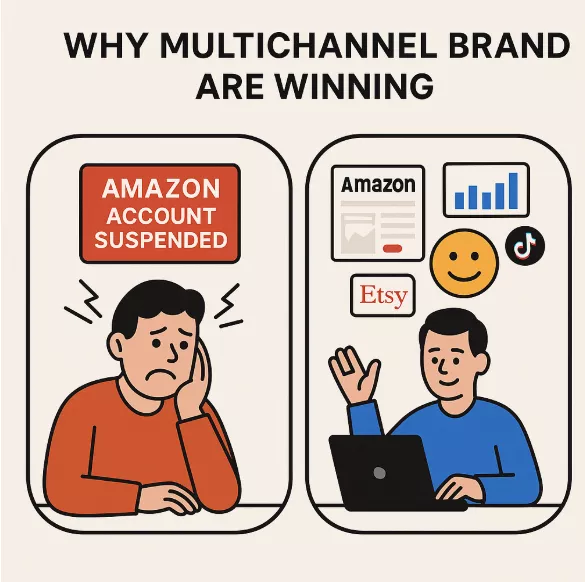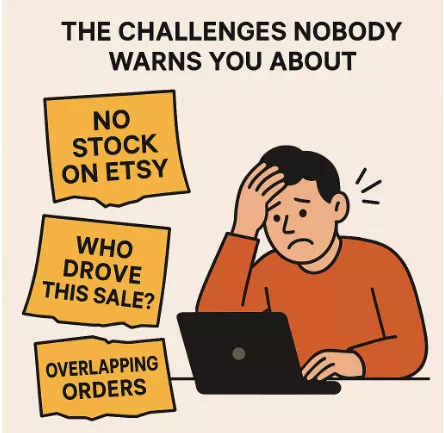It’s the Golden Rule of business: Don’t put all your eggs in one basket.
But most Amazon sellers are doing exactly that, and it’s keeping them up at night. If your entire business lives and dies by Amazon’s ever-changing policies, algorithm updates and fee structures, you’re basically playing a game of chance with your livelihood. A multichannel strategy isn’t just smart business anymore; it’s crucial.
Discover how our Amazon market strategy services can diversify your sales channels.
What Is an Amazon Multichannel Strategy?
An Amazon multichannel strategy means you’re selling your products across multiple platforms and sales channels, not just Amazon. Your direct-to-consumer (DTC) website might be one channel. Add Walmart, Etsy, eBay and TikTok Shop into the mix, and suddenly you’ve got options.
But here’s where it gets interesting: Amazon itself becomes part of your broader multichannel marketing for Amazon approach. You’re not abandoning Amazon — you’re using it as one powerful piece of a larger puzzle while simultaneously using other channels to promote Amazon store visibility.
A true multichannel selling strategy includes multiple sales channels, integrated inventory management, coordinated marketing using paid social and email marketing, unified fulfillment strategy and cross-platform customer data.
Why Multichannel Brands Are Winning
Diversify Your Risk
Imagine waking up to an email saying your Amazon account has been suspended. One email from Amazon shouldn’t end your business — unless Amazon is your business. Multichannel brands don’t live with that kind of anxiety.
Increase Your Visibility
Different customer demographics shop on different platforms. Gen Z is on TikTok. Millennials scroll Instagram. Boomers are loyal Amazon shoppers. By showing up where your customers actually are, you’re meeting people at their preferred shopping destination.
Higher Customer Lifetime Value
When you’re not paying Amazon’s 15% referral fee on every sale, you can afford better deals that build customer loyalty. This is where the DTC model shines. Sure, Amazon gives you instant credibility and traffic, but your own website gives you customer relationships.
Strategic Fulfillment Flexibility
With over 1 million robots handling delivery in the U.S., Amazon has built the biggest logistics chain in the country. You can use Amazon Multi-Channel Fulfillment to fulfill orders from your Etsy shop or DTC website using Amazon’s infrastructure. Unless you’re planning to build your own delivery network (you’re not), this is a game-changer.
The Challenges Nobody Warns You About
Too Many Channels, Too Little Focus
You can get a 1x increase in revenue but end up with a 2x increase in ad spend. That’s expensive chaos. The key is strategic expansion, not platform hoarding.
Inventory Organization
You have one unit left. A customer buys it on your website at 2:47 p.m. Another buys the “same” unit on Amazon at 2:48 p.m. Without proper inventory management, you’re constantly playing whack-a-mole with stock levels across platforms.
Fragmented Customer Data
When your traffic comes from Instagram, Google Ads, email marketing and organic search, it becomes incredibly hard to measure what really drove the sale. You end up with data scattered across platforms, making it impossible to figure out which marketing efforts actually work.
The Channels Worth Your Attention
- Your Direct-to-Consumer Website: Your DTC website is where you control everything — the customer experience, the branding, the data, the margins. You can even add a “Buy on Amazon” button for customers who prefer Prime shipping.
- Social Media Platforms: Want to promote your Amazon store with social media? Each platform has its own vibe. Instagram is visual storytelling. Facebook has older demographics with money to spend. Let’s say you bought a Ferrari through Walmart. It’s still a Ferrari, but the vibe is different.
- Influencer Platforms and UGC: User-generated content and influencer partnerships are goldmines for building trust. Real people using your product builds real trust.
- Meta Ads, Google Ads and Paid Social: Want to know how to drive external traffic to Amazon quickly? Paid advertising is your expressway. Meta ads can target specific demographics with precision. Google Ads captures people actively searching for your products.
- Amazon Brand Referral Bonus Program: Amazon will actually pay you to bring your own traffic to their platform. Through the Brand Referral Bonus program, you can earn 10% (the percentage varies by category, often 5%–10%) back on referral fees when you drive external traffic using attribution tags. Use shortened URLs (like Bitly) to analyze exactly how many clicks you’re getting from each channel.
Step-by-Step Implementation Guide
Step 1: Audit Your Current Amazon Presence
Before you chase shiny new channels, understand where you’re starting from. Audit your current Amazon traffic sources, your ad efficiency and your marginality. What’s your monthly revenue? What percentage is profit after fees? Where does your traffic come from? You need to create a base business first, then build on that foundation.
Step 2: Define Your Customer Journey
Not all customers take the same path to purchase. Cosmetics and fashion brands should be on Instagram and TikTok where visual discovery drives purchases. B2B industrial products? LinkedIn and Google Ads might be your winners. Map out where your customers discover products, what information they need and which touchpoints influence their decision.
Step 3: Choose Your Next Channel Strategically
Use tools like SimilarWeb or marketplace data to find where your customers are actually coming from. Don’t pick channels because they’re trendy. Pick them because your customers are already there.
Step 4: Optimize Content for Each Channel
Cookie-cutter content fails. Your Amazon listing needs keyword-rich bullet points. Your Instagram needs scroll-stopping visuals. Your email marketing needs subject lines that get opened. Adapt your product photos, descriptions and messaging for each channel’s unique audience.
Step 5: Integrate Your Inventory Management
This is non-negotiable. You absolutely must have a system that updates inventory across all sales channels in real-time. When you can’t measure something, you can’t control it. Invest in systems that give you visibility into what’s selling where and when to reorder.
Step 6: Control Your Fulfillment
Decide how you'll fulfill orders from each channel. Will you use Amazon Multi-Channel Fulfillment for everything? Maintain your own warehouse? For everything else, leveraging Amazon’s logistics often makes the most sense.
Step 7: Set Up Tracking and Attribution
Install Amazon Attribution tags on all external marketing efforts. Use UTM parameters on your links. Set up conversion tracking. Create unique promo codes for different channels. The Amazon Brand Referral Bonus program gives you both financial incentives and attribution data — use it.
Step 8: Test, Measure and Optimize
Launch small, measure results and scale what works. Don’t blow your entire marketing budget testing five channels simultaneously. Pick one new channel, run targeted campaigns, measure customer acquisition cost and decide whether to scale, optimize or pivot.
Building Your Multichannel Brand
Use Amazon as Your Proof of Concept: Smart multichannel brands use Amazon first to validate products and build reviews, then leverage that proof to launch on other platforms. You can add Amazon reviews to your own website to build immediate credibility.
Time Your Channel Expansion: For new products, focus on Amazon first to build velocity and reviews. Once you’ve got social proof, start driving external traffic from other channels.
Platform-Specific Content Is Non-Negotiable: Each platform has its own culture. TikTok needs authentic, unpolished content. Instagram wants aesthetic cohesion. Amazon demands information density. Adapt or fail.
Leverage Multi-Channel Fulfillment: If you don’t have your own warehouse, Amazon Multi-Channel Fulfillment is highly effective. It's more expensive than FBA, but dramatically cheaper than building your own logistics network.
Invest in Proper Systems Before You Scale: Inventory management software, order management systems and analytics platforms aren’t luxuries — they’re the foundation that prevents expensive mistakes as you grow your business.
While you’re building your multichannel presence, consider working with specialists who understand the complete e-commerce ecosystem. Our Amazon agency services help brands integrate Amazon strategically into a broader multichannel approach.
Explore our case studies to see multichannel success stories.
The Future of Multichannel Commerce
AI-powered chat interfaces like Alexa and ChatGPT are reshaping how consumers discover and purchase products. The brands that win will be the ones meeting customers wherever they are. When AI can find the cheapest option instantly, why should someone choose your brand? Because they feel connected to your mission, values and community.
Create a Business That Can Weather Any Storm
Depending entirely on Amazon is a risky bet. Platform policies change. Algorithms shift. Competition intensifies. If your entire business lives on one platform, you’re one policy change away from disaster.
A well-executed multichannel strategy opens up new customer segments, increases lifetime value and gives you control over your business destiny. Yes, it’s more complex. Yes, it requires investment in systems and processes. But the alternative is hoping Amazon never changes the rules on you, and that’s not a business strategy — that’s wishful thinking.
Start small. Audit where you are now. Choose your next channel strategically. Multichannel success is about being in the right places with the right message at the right time.
Ready to build a multichannel strategy that actually works? Learn how to promote products on Amazon effectively as part of your broader growth strategy.
Get started with a comprehensive multichannel strategy.
Read our e-book, Beyond Amazon: Building a Multichannel Empire That Reduces Platform Dependency.
FAQ
What is a multi-channel promotion strategy?
A multichannel promotion strategy means you’re marketing and selling your products across multiple platforms simultaneously — Amazon, your own website, social media platforms, other marketplaces and more. Instead of relying on one channel, you diversify to reduce risk, reach more customers and increase overall revenue.
Is Amazon Multi-Channel Fulfillment worth it?
Yes, Amazon Multi-Channel Fulfillment is absolutely worth it for sellers without their own warehouse infrastructure. While it’s more expensive per order than standard FBA, it's dramatically cheaper than building your own logistics network. You get Amazon’s fast delivery and established infrastructure, which builds trust with customers buying from your DTC website.
How do you grow your business with Amazon Multi-Channel?
Start by auditing your current Amazon performance and identifying your most profitable products. Then strategically choose one or two additional channels where your customers already are. Implement proper inventory management systems, create platform-specific content and use Amazon’s logistics for fulfillment. Track everything using attribution links and the Brand Referral Bonus program. Start small, measure results, and scale what’s working.
Related Articles
Segments vs. Audiences in Google Analytics 4: A Comprehensive Setup Guide
You will learn how to correctly set up custom audiences, allowing you to save time and gain insight into your audience
PPC for E-commerce: How to Buy Attention Without Going Broke
Learn how PPC for e-commerce can drive fast sales for your store without draining your budget. Smart strategies, beginner tips, and proven ways to scale profitably.
Personalization 2.0: Breaking the Deadlock of Cold Newsletters
Most leads in managerial positions receive dozens of similar messages every day. Below, I will present the algorithms and techniques that increased our partners' campaign conversion rates from 1% to 11%





